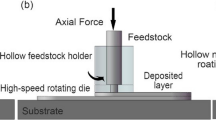Abstract
Induction heating of thermoplastic composites is a suitable and promising technique, due to the very short heating time and the possibility of generating the heat at the interface between the adherends compared with other heating technologies, i.e. owen heating or hot melt gun manual deposition. The aim of this work is to study the electromagnetic induction heating in adhesive bonding of thermoplastic matrix composite materials, when a hot-melt thermoplastic adhesive, Prodas, is used. A numerical model for studying the effect of the process parameters, such as current intensity, maximum temperature and holding time at maximum temperature, has been developed. Experimental tests validated the results of the numerical model; also, the mechanical properties of the adhesive joints were evaluated by short beam shear test and single lap shear tests to define the values of technological parameters allowing for the better joint strength. Moreover, ANOVA analysis was employed to evaluate the most significant parameter which affected the mechanical properties, highlighting the optimum process parameters.


















Similar content being viewed by others
References
Hallal A, Elmarakbi A, Shaito A, El-Hage H (2013) Overview of composite materials and their automotive applications. In: Advanced composite materials for automotive applications. Wiley, Chichester, pp 1–28
Ageorges C, Ye L, Hou M (2001) Advances in fusion bonding techniques for joining thermoplastic matrix composites: a review. Compos Part A Appl Sci Manuf 32:839–857. https://doi.org/10.1016/S1359-835X(00)00166-4
Teti R (2002) Machining of composite materials. CIRP Ann 51:611–634. https://doi.org/10.1016/S0007-8506(07)61703-X
Sheikh-Ahmad JY, Almaskari F, Hafeez F (2019) Thermal aspects in machining CFRPs: effect of cutter type and cutting parameters. Int J Adv Manuf Technol 100:2569–2582. https://doi.org/10.1007/s00170-018-2881-1
Skeist I (2012) Handbook of adhesives. Springer Science & Business Media, Berlin
Leone C, Genna S (2018) Effects of surface laser treatment on direct co-bonding strength of CFRP laminates. Compos Struct 194:240–251. https://doi.org/10.1016/J.COMPSTRUCT.2018.03.096
Pizzorni M, Lertora E, Gambaro C, Mandolfino C, Salerno M, Prato M (2019) Low-pressure plasma treatment of CFRP substrates for epoxy-adhesive bonding: an investigation of the effect of various process gases. Int J Adv Manuf Technol 102:3021–3035. https://doi.org/10.1007/s00170-019-03350-9
Haimbaugh RE (2015) Practical induction heat treating. ASM International, Cleveland
Sergio Lupi, Michele Forzan, Aleksandr Aliferov (2015) Induction and Direct Resistance Heating
Miller AK, Chang C, Payne A, Gur M, AP EM (1990) The nature of induction heating in graphite–fiber, polymer–matrix composite materials. SAMPE J 26:37–54
Fink BK, McCullough RL, Gillespie JW (2004) A local theory of heating in cross-ply carbon fiber thermoplastic composites by magnetic induction. Polym Eng Sci 32:357–369. https://doi.org/10.1002/pen.760320509
Yarlagadda S, Kim HJ, Gillespie JW et al (2002) A study on the induction heating of conductive fiber reinforced composites. J Compos Mater 36:401–421. https://doi.org/10.1177/0021998302036004171
Sánchez Cebrián A, Zogg M, Ermanni P (2013) Methodology for optimization of the curing cycle of paste adhesives. Int J Adhes Adhes 40:112–119. https://doi.org/10.1016/j.ijadhadh.2012.09.002
Severijns C, de Freitas ST, Poulis JA (2017) Susceptor-assisted induction curing behaviour of a two component epoxy paste adhesive for aerospace applications. Int J Adhes Adhes 75:155–164. https://doi.org/10.1016/j.ijadhadh.2017.03.005
Gouin O’Shaughnessey P, Dubé M, Fernandez Villegas I (2016) Modeling and experimental investigation of induction welding of thermoplastic composites and comparison with other welding processes. J Compos Mater. https://doi.org/10.1177/0021998315614991
Chadegani A, Batra RC (2011) Analysis of adhesive-bonded single-lap joint with an interfacial crack and a void. Int J Adhes Adhes 31:455–465. https://doi.org/10.1016/J.IJADHADH.2011.02.006
Luo Q, Tong L (2009) Analytical solutions for nonlinear analysis of composite single-lap adhesive joints. Int J Adhes Adhes 29:144–154. https://doi.org/10.1016/J.IJADHADH.2008.01.007
da Silva LFM, das Neves PJC, Adams RD, Spelt JK (2009) Analytical models of adhesively bonded joints—part I: literature survey. Int J Adhes Adhes 29:319–330. https://doi.org/10.1016/J.IJADHADH.2008.06.005
de Castro J, Keller T (2008) Ductile double-lap joints from brittle GFRP laminates and ductile adhesives, part I: experimental investigation. Compos Part B Eng 39:271–281. https://doi.org/10.1016/J.COMPOSITESB.2007.02.015
Reis PNB, Ferreira JAM, Antunes F (2011) Effect of adherend’s rigidity on the shear strength of single lap adhesive joints. Int J Adhes Adhes 31:193–201. https://doi.org/10.1016/J.IJADHADH.2010.12.003
Pahr DH, Rammerstorfer FG, Rosenkranz P et al (2002) A study of short-beam-shear and double-lap-shear specimens of glass fabric/epoxy composites. Compos Part B Eng 33:125–132. https://doi.org/10.1016/S1359-8368(01)00063-4
Precision WS (2011) Standard test method for short-beam strength of polymer matrix composite materials. Annu B ASTM Stand 00:1–8. https://doi.org/10.1520/D2344
Specimen J, Results T (2005) ASTM D5868 standard test method for lap shear adhesion for fiber reinforced plastic ( FRP ). Reproduction 01:4–5. https://doi.org/10.1520/D5868-01R14.2
Ahmed TJ, Stavrov D, Bersee HEN, Beukers A (2006) Induction welding of thermoplastic composites—an overview. Compos Part A Appl Sci Manuf 37:1638–1651. https://doi.org/10.1016/J.COMPOSITESA.2005.10.009
Li X, Strieder W (2009) Emissivity of high-temperature fiber composites. Ind Eng Chem Res 48:2236–2244. https://doi.org/10.1021/ie8008583
Kranjc M, Zupanic A, Miklavcic D, Jarm T (2010) Numerical analysis and thermographic investigation of induction heating. Int J Heat Mass Transf 53:3585–3591. https://doi.org/10.1016/J.IJHEATMASSTRANSFER.2010.04.030
Acknowledgements
The authors would like to kindly acknowledge Dr. Francesco Galise of CRF (Fiat Research Center), Pomigliano d’Arco, Naples, Italy, for the technical support.
Author information
Authors and Affiliations
Corresponding author
Additional information
Publisher’s note
Springer Nature remains neutral with regard to jurisdictional claims in published maps and institutional affiliations.
Rights and permissions
About this article
Cite this article
Nele, L., Palmieri, B. Electromagnetic heating for adhesive melting in CFRTP joining: study, analysis, and testing. Int J Adv Manuf Technol 106, 5317–5331 (2020). https://doi.org/10.1007/s00170-019-04910-9
Received:
Accepted:
Published:
Issue Date:
DOI: https://doi.org/10.1007/s00170-019-04910-9




